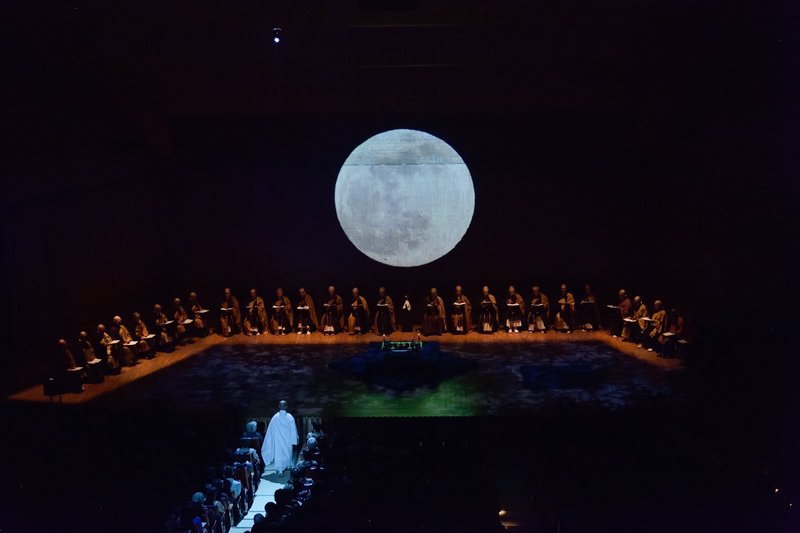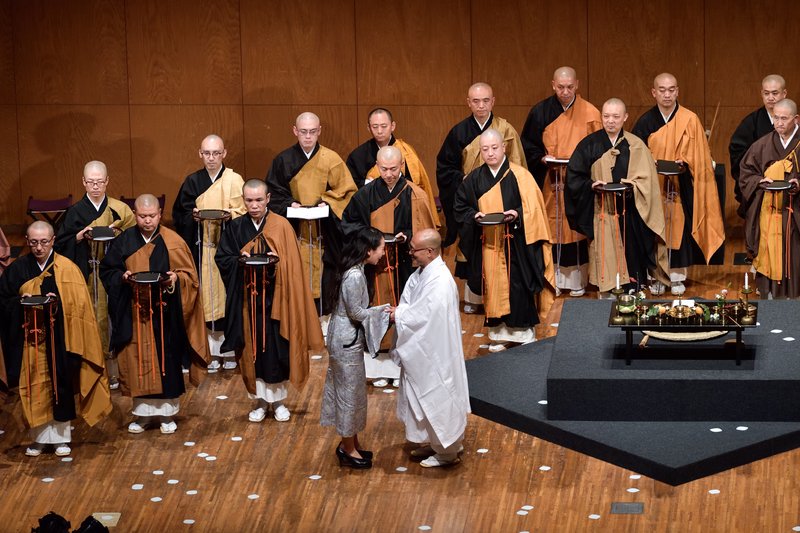
月の光言
作曲年/2017
編成/真言宗豊山派と天台宗の声明(初演時は31名の僧侶による)
テキスト/明恵上人の月を詠んだ和歌、光明真言、兼好法師「徒然草」より
演奏時間/約90分(古典声明のお唱えを含む)
神奈川県立音楽堂(神奈川芸術文化財団)の委嘱により、音楽堂・伝統音楽シリーズ 聲明「月の光言(こうごん)」のために作曲。
English title: Moonlight Mantra (Tsuki no Kōgon)
Year of composition: 2017
Instrumentation: Shōmyō (Japanese Buddhist chant of Shingon sect and Tendai sect, 31 priests for the world premiere)
On the several poetries (in Waka style) by Myōe-shōnin, 'Mantra of Light,' and an excerpt from 'Tsurezuregusa (Essays in Idleness)' by Kenkō Yoshida
Duration: approximately 90 minutes (including traditional parts)
Commissioned by Kanagawa Kenritsu Ongakudō (Kanagawa Prefectural Music Hall); first performed at Japanese Traditional Music Series

作曲ノート
私はいったい何者なのか。私にとって、作曲という行為は、この答えのない問いに向き合い、あらためて自分になるための手段です。自分の在り方、ひいては、人の生き方というものを尋ね、自分自身の音楽を探し求める。私はなぜ、日本に、日本人として生まれたのだろうか。自らの起源にさかのぼろうと、日本の音や音楽の源流にまで立ち返ることになります。
音楽は、洋の東西を問わず、豊作、豊漁や子孫繁栄などの人々の生活上の切実な願いから、その歴史が始まっています。生き延びるために、どうにかして、神に祈りの言葉を届けなければならない。神々の注意を引きつけようと、音声の強弱、長短、音高の変化、抑揚などをつけ、言葉の読み上げ方の工夫が重ねられたのでしょう。祈りの言葉の読み上げ方がより発達し、ますます複雑化して旋律のようになったところに、声楽が始まったのだと考えられます。音や音楽の起源にさかのぼろうとすると、宗教音楽について考える必要に迫られるのです。
聲明という仏教声楽の世界を初めて知ったのは二〇〇九年のことで、それ以来、聲明の取材を続けています。聲明のための大きな作品は《月の光言》で三作目となります。聲明のために曲を書くことは、日本人である私を再発見することです。作曲家がいまの時代に新しい聲明曲を書く意味を自問自答しつつ、聲明ならではの様式感、古典の節回しに学びながら作曲しています。
《月の光言》は、天台宗と真言宗豊山派の僧侶たちによって唱えられる作品です。二〇一七年に神奈川県立音楽堂の委嘱で作曲し、その十一月に初演されました。テキストに、明恵上人の月の和歌数首、明恵上人が改めてその素晴らしさを見出した「光明真言」、そして「徒然草」第一五五段の一部を用いています。
「あかあかや」の和歌を用いた冒頭は、明恵上人が松林のなか、坐禅を組む様子が描かれた「樹上坐禅像」からインスピレーションを得、《月の光言》全体の序として作曲しました。僧侶たちの声を、松林にひそむ獣や魑魅魍魎の声に見立て、その唸り声の混沌のなか、明恵上人が月をともなって現れます。「あかあかや」は、感動の声をそのまま連ねたような和歌ですが、これこそが「歌」の本来の姿であろうと思います。人は、心を動かされる事があったとき、つまり、外から何か圧力がかかったとき、その緊張の状態から解放されるために、自身の内部に感じられる混乱を整えようと、思わず長くため息をつきます。そのような、人が極めて自然に取る動作から「ほころび出」た、言葉以前のひとつの声が、言葉の基礎であり、歌の基礎であります。「あかあかや」の和歌は、始めは一字ずつ、言葉が解体された「音」の状態で提示され、発声が独唱から僧侶全体に広がっていくとともに、徐々に意味が形成されていきます。
「問訊」作法を伴う「光明真言」二遍は、両宗派の聲明の特徴的な旋律形を行ったり来たりするような節回しで作曲しました。続く「大行道」では、「光明真言」が三パターンのちがう速さで唱えられ、それらが重なり合い、会場全体に光明真言の輪が広がります。
「かきつくる」「くまもなく」「くまもなき」の和歌については、その和歌の言葉が元来持つリズムや響きを活かしつつ、音と意味が分断されないように節付けしようとすると、聲明ならではの旋律形だけではうまくいかなかったため、能謡の節回しも参考にしながら作曲しました。「徒然草」は、講式、表白などの語りに近い聲明の様式や、節談説教などを意識し、「語り」と「節」のあいだを揺れ動くような旋律が、導師とソリストとの間で取り交わされるよう構成しています。
終盤、天台宗の「くまもなく」と真言宗の「くまもなき」の掛け合いは、いつしか「あかあかや」の掛け合いとなります。「あかあかや」は母音の「ア」をベースとした歌で、その「ア」の音が、光明真言の「ア」の音と重なり、さらに、無限の空間を意味する「阿」「吽」となって、作品が締めくくられます。
新作部分で僧侶たちが用いる楽譜は、試行錯誤の末につくり上げた、新しいフォーマットで記譜しています。それによって、綿密に「節」を組み合わせたアンサンブルを実現することができます。普段の古典の譜とは違う形の楽譜に、愛情を持って果敢に取り組んでくださる僧侶のみなさま、いつも学びの場を与えてくださる演出の田村博巳先生に、深く感謝申し上げます。《月の光言》が、聴いてくださるみなさまに、癒しだけでなく、何かを問いかけ、新しい気づきをもたらすことを願っています。
Composer's note
Who am I? Why was I born in Japan as a Japanese person? For me, composing was the means to face these unanswerable questions and rediscover myself. When I tried to find my roots and define my position, I would reach toward Japanese sound and the origins of Japanese music.
For the last 10 years, I have dedicated myself to researching and studying shomyo. I composed Moonlight Mantra in 2017 through a commission from the Kanagawa Prefectural Music Hall. It was my third large-scale shomyo composition. The texts I used for this composition were a few poems written by the Buddhist monk Myoe (1173-1232), Komyo Shingon (Mantra of Light), and an excerpt from the 155th passage of Tsurezuregusa (Essays in Idleness) by Kenko Yoshida (1283–1350). I composed this music to shift between two shomyo styles—the Tendai sect’s style and the Buzan School of Shingon sect’s style. And I wrote this in a special notation that I invented through a lengthy trial and error process. Traditional shomyo is typically sung in unison; however, this new notation enabled me to arrange elaborate phrases.
I hope that Moonlight Mantra will bring peace of mind to each audience member and present an opportunity to review one’s way of life and discover something new.
presented byJapan Society and The University of Chicago Presents (March 2021)
DVD収録に寄せた作曲ノート
私はいったい何者なのか。なぜ日本に、日本人として生まれたのだろうか。私にとって作曲とは、これらの答えのない問いに向き合い、改めて自分になるための手段です。自らの在り方を尋ね、その起源にさかのぼろうとすると、日本の音や音楽の源流にまで立ち返ることになるのです。
これまで十数年、聲明の取材と研究を続けています。《月の光言》は、二〇一七年、神奈川県立音楽堂の委嘱により作曲しました。聲明のための大きな作品はこれで三作目となります。天台宗と真言宗豊山派の特徴的な節回しを行き来するように作曲し、試行錯誤の末につくり上げた新しいフォーマットで記譜しました。
ここに収録されたヴァージョンは、約四十分のダイジェストです。本来の《月の光言》の演奏時間は、その倍くらい、約九十分あります。月をともない、山深く分け入る明恵上人を迎える動物たち、自然、魑魅魍魎の声が縦横無尽に重なり合う冒頭、色とりどりの独唱の声で僧侶たちが唄い継ぐ徒然草など、収録に至らなかった部分にも、聴きどころがまだたくさんあります。この映像作品でおおよその輪郭をつかんでいただき、また《月の光言》の音楽全体を多くの方に体験いただける機会があることを切望します。
《月の光言》が人の生き方を問い、癒しだけでなく新しい気づきをもたらすことを願ってやみません。
使用テキスト(Lyrics)
唄 Bai (Hymn of Praise)
あかあかや あかあかあかや あかあかや
あかあかあかや あかあかや月
Aka aka ya aka aka aka ya aka aka ya
aka aka aka ya aka akaya tsuki
(Bright, bright moon.)
原典:明恵上人の月を詠んだ和歌(『明恵上人集』より)
A hymn of praise based on one of Myoe’s poems, this piece depicts the Buddhist poet hearing the bell signaling the late-night vigil as he ascends to the hall on the nearby peak, drawn by voices singing, “Bright, bright!”
法則 Hossoku (Liturgy)
<光明 Komyo (Immeasurable Light)
- 逆酒水 Gyaku-shasui (Ritual purifying the place of worship)>
かきつくるあとに光のかがやけば
暗き道にも闇は晴るらむ
Kaki tukuru ato ni hikari no kagayake ba
kuraki michi nimo yami wa haru ran
(When the Light Mantra shines on the deceased person’s writings, it will light his way to the other world.)
原典:明恵上人の月を詠んだ和歌(『明恵上人集』より)
This poem, written by Myoe, is praising the merits of Komyo Shingon, or Light Mantra.
------
<問訊 Monjin (Ritual gesture of worship)
- 光明真言 Komyo Shingon (Light Mantra)>
唵 阿謨伽 尾盧左曩 摩訶母捺囉
麽抳 鉢納麽 入嚩攞 鉢囉韈哆野 吽
On abokya beiroshanou makabodara
mani handoma jinbara harabaritaya un
(Praise be to the unfailing, all-pervasive illumination of the great mudra (or seal of the Buddha), the jewel, the lotus, and the radiant light existing in our world.)
原典:光明真言
Popularized by Myoe, it is believed in Shingon Buddhism that if one chants this mantra with sincere devotion and clarity of mind, while shedding the illusion of one’s personhood, Buddha will rid them of all ignorance and delusion by placing his seal upon the chanter.
語り Katari (Narrative)
<生死 Shoji (On Life and Death)>
春暮れて後、夏になり、夏果てて、秋の来るにはあらず。春はやがて夏の気を催し、夏より既に秋は通ひ、秋は即ち寒くなり、十月は小春の天気、草も青くなり、梅も蕾みぬ。木の葉の落つるも、先ず落ちて芽ぐむにはあらず、下より萌しつはるに堪へずして落つるなり。迎ふる気、下に設けたる故に、待ちとる序甚だ速し。
生・老・病・死の移り来る事、また、これに過ぎたり。四季は、なほ、定まれる序あり。死期は序を待たず。死は、前よりしも来らず。かねて後に迫れり。人皆死ある事を知りて、待つことしかも急ならざるに、覚えずして来る。沖の干潟遥かなれども、磯より潮の満つるが如し。
(Summer does not come once spring is done, nor autumn arrive at the end of summer. Spring begins early to hold summer’s intimations, while hints of autumn already come and go within summer, and no sooner is autumn here than winter’s cold begins. The tenth month, winter’s start, has a spring-like warmth that greens the plants and swells the buds on the plum.)
原典:吉田兼好『徒然草』第155段より
Taken from a part of the 155th passage of Tsurezure gusa (Essays in Idleness), written by the Japanese monk Kenko Yoshida sometime between 1330 and 1332, the text situates death and the impermanence of human existence as distinct within the seasonal changes of nature.
Eko Kada 回向伽陀 (Hymn for Transfer of Merit)
くまもなく澄める心のかがやけば
わが光とや月思ふらむ
Kuma mo naku sumeru kokoro no kagayake ba
waga hikari toya tsuki omou ran
(My crystal clear heart is shining from end to end; the moon might think it’s its own lights.)
くまもなき心のうちの光こそ
まことの月のかげにありけめ(返し歌)
Kuma mo naki kokoro no uchi no hikari koso
makoto no tuski no kage ni ari keme
(The light from an unclouded heart must be hidden in the real moon’s reflection.)
あかあかや あかあかあかや あかあかや
あかあかあかや あかあかや月
Aka aka ya aka aka aka ya aka aka ya
aka aka aka ya aka akaya tsuki
(Bright, bright moon.)
原典:明恵上人の月を詠んだ和歌(『明恵上人集』より)
There are three poems in this section meant to evoke the image of Myoe sitting in the meditation hall of his temple in the dark before dawn. He envisions within his heart the full moon as it sets in the western sky, meditating in a state of unity with the cosmos.
The first stanza is a poem by Myoe, while the second is a poem written in response by his disciple Kakuchi (Adachi Kagemori). Kagemori was a samurai who captured Myoe, but later became one of his followers under the name Kakuchi. The last poem is a reiteration of the poem at the top of this program called Aka Aka Ya.
Promotion movie
Performance history
(As of 19 August 2022)
2017年11月4日 - 世界初演
神奈川県立音楽堂・伝統音楽シリーズ - 聲明「月の光言(こうごん)」
@神奈川県立音楽堂(神奈川県横浜市西区紅葉ヶ丘9-2)
出演/声明の会・千年の聲(迦陵頻伽聲明研究会と七聲会による)
♦︎迦陵頻伽聲明研究会(真言宗豊山派)
新井弘順、大平稔雄、斎藤説成、小路耕徳、塚越秀成、塚田康憲、鷲見弘道、沼尻憲尚、戸部憲海、孤島泰凡、清水義英、多田康雄、青木亮敬、新井弘賢、山崎一晃、堀内明大、谷口誠順
♦︎七聲会(天台宗)
玉田法信、杉山幸雄、平田真紹、室生述成、末廣正栄、宇佐見孝昭、鈴木亮仁、豊田良栄、友光雅臣、佐野充広、髙栁亮伯、大野豪祐、波母山淳信、雨宮亮祐
構成・演出/田村博巳
www.kanagawa-ongakudo.com/detail?id=34896

2020年12月19日
日本人と自然 ~しみじみとやさしい日本人の心の歌~
聲明《月の光言》~明恵上人集より~
@静岡音楽館AOI(静岡県静岡市葵区黒金町1-9 静岡中央郵便局うえ7-9階)
出演/声明の会・千年の聲(声明)
構成・演出/田村博巳
www3.aoi.shizuoka-city.or.jp/concert/detail.php?y_yoyaku_day_uid=17593
[limited video streaming] 2021年2月1日〜20日
「声明の会・千年の聲」による新作聲明、作曲は才気溢れる現代音楽作曲家、桑原ゆう。
冴え冴えと澄み渡る冬の月
お堂にこだまする光明真言の厳かな響き
曇りなき心で月と一体となる明恵上人を謳います。
------
新作聲明「月の光言」ダイジェスト版約40分(本来のステージ版は約90分)に、特典映像として新井弘順(導師)、田村博巳(演出)、桑原ゆう(作曲)のインタビューが付いた、計約60分の映像作品のオンデマンド配信です。
♦︎観劇三昧でのご視聴:v2.kan-geki.com/tvods/detail/30
♦︎360channelでのご視聴:360ch.tv/video/show/3005
♦︎U-NEXTでのご視聴:video.unext.jp/title/SID0055313
------
出演/声明の会・千年の聲
演出・構成/田村博巳
作曲/桑原ゆう
映像/PLASTIC RAINS、GOCCHA
音響/株式会社 Fly sound
照明/アーツラボ
PR/GOCCHA、アーツラボ
協力/安養院
プロデューサー/花光潤子
製作/NPO魁文舎
助成/日本万国博覧会記念基金
文化庁委託事業「文化芸術収益力強化事業」
[online concert & limited streaming] 30 March 2021 - online US premiere
JAPAN SOCIETY - Online Traditional Music
Shomyo: Buddhist Ritual Chant - Moonlight Mantra
Co-presented with University of Chicago Presents
www.japansociety.org/event/shomyo-buddhist-ritual-chanting-mantra-of-moonlight
artsinitiative.columbia.edu/event/shomyo-buddhist-ritual-chant-moonlight-mantra/
------
新作聲明「月の光言」ダイジェスト版約40分(本来のステージ版は約90分)に、特典映像として新井弘順(導師)、田村博巳(演出)、桑原ゆう(作曲)のインタビューが付いた映像作品。2月に日本で配信された内容を、ジャパン・ソサエティーがオンラインコンサートとして配信します。世界各地で視聴可能です。配信公演後、新井弘順先生を迎え、ライブQ&Aが行われます。
issuu.com/uchicagopresents/docs/ucp_2020-21_shomyo_no_kai_program_book
------
出演/声明の会・千年の聲
演出・構成/田村博巳
作曲/桑原ゆう
映像/PLASTIC RAINS、GOCCHA
音響/株式会社 Fly sound
照明/アーツラボ
PR/GOCCHA、アーツラボ
協力/安養院
プロデューサー/花光潤子
製作/NPO魁文舎
助成/日本万国博覧会記念基金
文化庁委託事業「文化芸術収益力強化事業」
この記事が気に入ったらサポートをしてみませんか?
